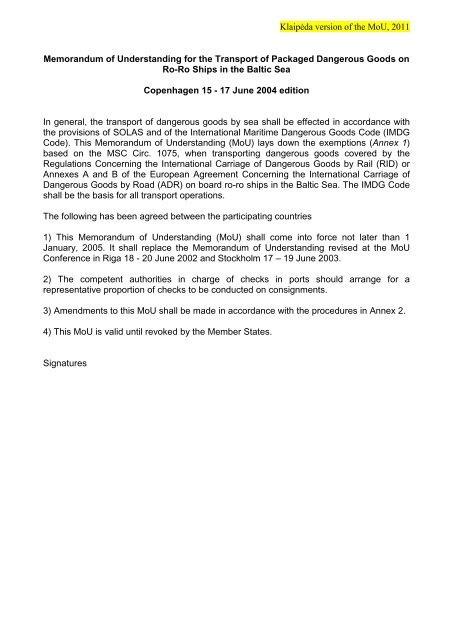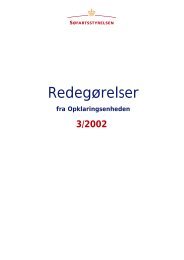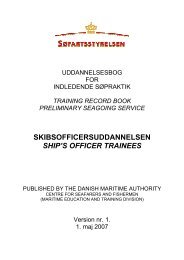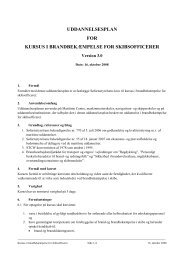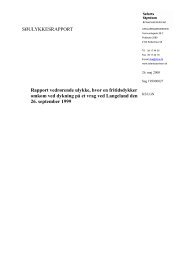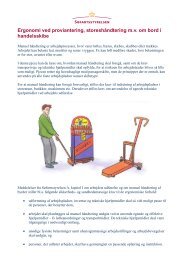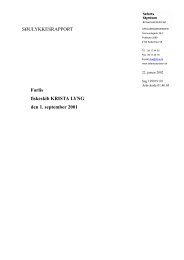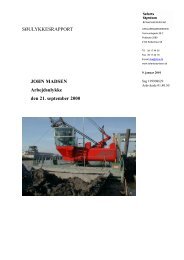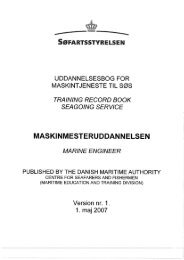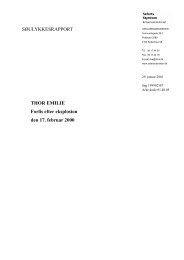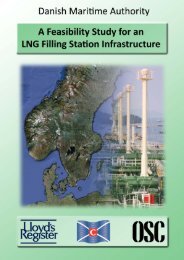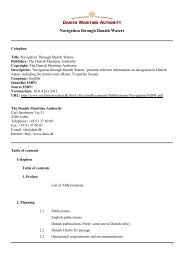MEMORANDUM OF UNDERSTANDING
MEMORANDUM OF UNDERSTANDING
MEMORANDUM OF UNDERSTANDING
Create successful ePaper yourself
Turn your PDF publications into a flip-book with our unique Google optimized e-Paper software.
Klaipėda version of the MoU, 2011<br />
Memorandum of Understanding for the Transport of Packaged Dangerous Goods on<br />
Ro-Ro Ships in the Baltic Sea<br />
Copenhagen 15 - 17 June 2004 edition<br />
In general, the transport of dangerous goods by sea shall be effected in accordance with<br />
the provisions of SOLAS and of the International Maritime Dangerous Goods Code (IMDG<br />
Code). This Memorandum of Understanding (MoU) lays down the exemptions (Annex 1)<br />
based on the MSC Circ. 1075, when transporting dangerous goods covered by the<br />
Regulations Concerning the International Carriage of Dangerous Goods by Rail (RID) or<br />
Annexes A and B of the European Agreement Concerning the International Carriage of<br />
Dangerous Goods by Road (ADR) on board ro-ro ships in the Baltic Sea. The IMDG Code<br />
shall be the basis for all transport operations.<br />
The following has been agreed between the participating countries<br />
1) This Memorandum of Understanding (MoU) shall come into force not later than 1<br />
January, 2005. It shall replace the Memorandum of Understanding revised at the MoU<br />
Conference in Riga 18 - 20 June 2002 and Stockholm 17 – 19 June 2003.<br />
2) The competent authorities in charge of checks in ports should arrange for a<br />
representative proportion of checks to be conducted on consignments.<br />
3) Amendments to this MoU shall be made in accordance with the procedures in Annex 2.<br />
4) This MoU is valid until revoked by the Member States.<br />
Signatures
Annex 1<br />
as amended in Klaipėda<br />
8-9 September 2011<br />
Memorandum of Understanding for the Transport of Packaged Dangerous Goods in the Baltic Sea<br />
Section 1<br />
Application<br />
(1) By derogation from the provisions of the IMDG Code, these provisions may be applied on all ro-ro ships<br />
operating within the Baltic Sea proper, the Gulf of Bothnia, the Gulf of Finland and the entrance to the Baltic<br />
Sea bounded in the north by the line Skaw-Lysekil provided that the requirements following below are met.<br />
(2) Ro-ro ships having been issued with a Document of Compliance in accordance with Section 8 below may<br />
carry, at the same time, cargo transport units (CTUs) which either fulfil the requirements of RID/ADR or of<br />
the IMDG Code.<br />
(3) Dangerous goods, which either fulfil the requirements of the IMDG Code or RID or ADR may be loaded<br />
together in the same CTU (see Section 4).<br />
Section 2<br />
Definitions<br />
(1) The terms used in this MoU refer to the IMDG Code except those listed below in this section<br />
(2) Shipowner means company as defined in the ISM Code.<br />
(3) On-deck stowage means stowage on the weather deck.<br />
(4) Under-deck stowage means stowage in a cargo space; in an open ro-ro cargo space, unless it is<br />
considered by a competent authority to be a weather deck; and/or in a closed ro-ro cargo space, as<br />
appropriate.<br />
(5) Low Wave Height Area (LWHA) is a sea area where according to the Agreement concerning specific<br />
stability requirements for ro-ro passenger ships undertaking regular scheduled international voyages<br />
between or to or from designated ports in North West Europe and the Baltic Sea, 28 February 1996<br />
(Stockholm Agreement), set into effect on 1 April 1997, the significant wave height does not exceed 2.3<br />
metres more than 10 % of the year (see Appendix 1 of Annex 1). Traffic in other areas can be considered as<br />
LWHA traffic by the competent authorities concerned if equivalent safety can be assured.<br />
(6) The competent authorities in accordance with these provisions are:<br />
Denmark Danish Maritime Authority<br />
Vermundsgade 38 c<br />
DK-2100 COPENHAGEN O<br />
E-mail: info@dma.dk<br />
Estonia Estonian Maritime Administration<br />
Maritime Safety Division<br />
Valge 4<br />
EE-11413 Tallinn<br />
E-mail: mot@vta.ee<br />
Finland Finnish Transport Safety Agency<br />
P.O. Box 320<br />
FI-00101 HELSINKI<br />
E-mail: kirjaamo@trafi.fi<br />
2
Germany Federal Ministry of Transport, Building and Urban Affairs<br />
P.O. Box 20 01 00<br />
D-53170 BONN<br />
E-mail: Ref-UI33@bmvbs.bund.de<br />
Lithuania Lithuanian Maritime Safety Administration<br />
J. Janonio str. 24<br />
LT-92251 KLAIPEDA<br />
E-mail: msa@msa.lt<br />
Latvia Maritime Administration of Latvia<br />
5 Trijádibas str.<br />
LV-1048 RIGA<br />
E-mail: lja@lja.lv<br />
Poland Ministry of Infrastructure<br />
Ul. Chalubinskiego 4/6<br />
PL-00928 WARSAW<br />
E-mail: info@mi.gov.pl<br />
Sweden Swedish Transport Agency<br />
Box 653<br />
SE-601 15 NORRKÖPING<br />
E-mail: kontakt@transportstyrelsen.se<br />
Section 3<br />
Transport of dangerous goods<br />
(1) Dangerous goods that are classified, packaged, marked, labelled, documented and loaded together on or<br />
in a CTU or unit load in accordance with the requirements of RID, ADR or the IMDG Code may be<br />
transported in accordance with the provisions of this MoU.<br />
(2) The application of packing instruction R001 or section 4.1.4 of ADR or RID is allowed only for the traffic in<br />
LWHA.<br />
(3) Tanks shall either comply with chapter 4.2 ADR/RID/IMDG Code, as amended, or comply with chapter<br />
4.3 ADR/RID, as amended. Tanks with open venting devices should not be permitted for transport on board<br />
of ro-ro ships.<br />
(4) Bulk containers shall comply with chapter 7.3 ADR/RID, as amended, or 4.3 of the IMDG Code, as<br />
amended. For substances of class 4.3 only closed CTUs shall be used.<br />
(5) Vehicles (UN 3166 or 3171) loaded in a closed or sheeted CTU may be carried provided that the<br />
consignor or his representative informs the master about the presence of the vehicle.<br />
Section 4<br />
Loading and placarding of CTUs<br />
(1) Packages (packagings, large packagings or IBCs) containing dangerous goods shall be segregated from<br />
each other within CTUs in accordance with the provisions of the IMDG Code. For traffic in LWHA packages<br />
with segregation categories 1 and 2 of table 7.2.1.16 of the IMDG Code may be loaded together in the same<br />
CTU. Paragraph 7.5.2.2 Note a of RID/ADR may be used for traffic in LWHA.<br />
(2) Substances and articles assigned to class 1 or bearing a label of class 1 as subsidiary risk, shall be<br />
loaded and segregated in accordance with ADR/RID or the IMDG Code.<br />
(3) Placarding and marking of CTUs containing dangerous goods shall be in accordance with the provisions<br />
of the IMDG Code or RID/ADR, see Section 5.<br />
CTUs containing Marine Pollutants have to be marked according to the IMDG Code, if they are not marked<br />
according to section 5.3.6 of RID/ADR.<br />
3
Section 5<br />
Transport of CTUs<br />
CTUs containing dangerous goods may be carried on ro-ro ships in accordance with the following provisions:<br />
(1) A container/vehicle packing certificate (CTU packing certificate) shall be issued for each CTU containing<br />
dangerous goods. The model CTU packing certificate shall comply with the IMO/ILO/UN ECE Guidelines 1<br />
for<br />
packing of Cargo Transport Units (CTUs) referred to in Section 9 (2). For mixed loading for traffic in LWHA,<br />
the packing certificate shall state that any prohibition of mixed loading as specified in Section 4 (1) sentence<br />
2, has been complied with. In that case the following has to be stated in the packing certificate: “Packed<br />
together according to the MoU”.<br />
(2) When dangerous goods are transported in accordance with chapter 3.4 and/or 3.5 of RID or ADR the<br />
consignor or his representative shall provide the master with the following information: “Dangerous goods in<br />
limited and/or in excepted quantities of class(es)...“.<br />
When dangerous goods are transported in accordance with paragraphs 1.1.3.1 (b) – (f) or 1.1.3.2 (a) – (c) or<br />
(e) or 1.1.3.4.1 of RID /ADR, unless exempted by the IMDG Code, the consignor or his representative shall<br />
inform the master that these paragraphs are used.<br />
(3) CTUs as referred to in 1.1.3.4.2 RID/ADR and 1.1.3.6 ADR shall display on two opposite sides a neutral<br />
orange-coloured plate from the time they have been checked in at the port facility and during the voyage ,<br />
unless they are marked according to chapter 3.4 RID/ADR. The responsibility for fitting such plates shall rest<br />
with the person actually placing the CTU ready for loading on board the ro-ro ship.<br />
(4) When the placarding and marking of trailers without a motor vehicle is not in accordance with the<br />
provisions of the IMDG Code, the trailers shall display, on two opposite sides a neutral orange-coloured<br />
plate, from the time they have been checked in at the port facility and during the voyage. The responsibility<br />
for fitting such plates shall rest with the person actually placing the trailer ready for loading on board the ro-ro<br />
ship.<br />
(5) Orange-coloured plates mentioned in 5 (3) and 5 (4) means plates conforming to RID/ADR 5.3.2.<br />
Plates required only in the MoU shall be clearly visible and conform to RID/ADR 5.3.2.2.1 regarding size and<br />
colour. These plates may be replaced by self-adhesive sheets, by paint or by any other equivalent process.<br />
Section 6<br />
Stowage and segregation between CTUs<br />
(1) Segregation between CTUs shall be in accordance with the provisions of the IMDG Code, except that for<br />
LWHA traffic no separation is required for segregation categories 1 and 2 in table 7.2.4.2 of the IMDG Code.<br />
(2) Stowage and segregation of class 1 shall be in accordance with the IMDG Code and the Document of<br />
Compliance (SOLAS 1974, II-2/19).<br />
1 See IMDG Code, 5.4.2 and Supplement, 4.4.2.<br />
4
(3) The following table shall apply to the stowage of CTU containing dangerous goods:<br />
Stowage table for CTUs containing packaged dangerous goods of classes 2 to 9<br />
Note: Stowage shall also be in accordance with the Document of Compliance (SOLAS 1974, II-2/19) or<br />
the Letter of Compliance referred to in Section 8 of the MoU.<br />
Description and class as specified in<br />
IMDG Code/RID/ADR<br />
Gases<br />
Cargo ships<br />
or passenger ships carrying either not<br />
more than<br />
25 passengers or<br />
1 passenger per 3 metres of overall<br />
length *)<br />
Other passenger ships<br />
Description Class<br />
2<br />
On deck Under deck On deck Under deck<br />
-flammable gases.<br />
-non-flammable non-toxic<br />
gases.<br />
-toxic gases<br />
Flammable liquids<br />
- packing group I or II<br />
- packing group III<br />
Flammable solids<br />
- UN No.1944, 1945, 2254,<br />
2623<br />
- other UN numbers<br />
Substances liable to<br />
spontaneous combustion<br />
2.1<br />
2.2<br />
2.3<br />
3<br />
4.1 2)<br />
Permitted<br />
Permitted<br />
Permitted<br />
Permitted<br />
Permitted<br />
Permitted<br />
Permitted<br />
Prohibited<br />
Permitted 3)<br />
Prohibited<br />
Permitted<br />
Permitted<br />
Permitted<br />
Prohibited<br />
Prohibited<br />
Permitted 3)<br />
Prohibited<br />
Permitted<br />
Permitted<br />
Permitted<br />
Permitted<br />
Prohibited<br />
Permitted 3)<br />
Prohibited<br />
Prohibited<br />
Permitted<br />
Permitted<br />
Prohibited<br />
4.2 Permitted Prohibited Permitted Prohibited<br />
Substances which give off<br />
flammable gases in contact<br />
with water<br />
4.3 Permitted 1) Prohibited Permitted 1) Prohibited<br />
Oxidizing substances 5.1 Permitted Permitted Permitted Prohibited<br />
Organic peroxides 5.2 2) Permitted Prohibited Prohibited Prohibited<br />
Toxic substances<br />
6.1<br />
- packing group I or II<br />
Permitted Prohibited Permitted Prohibited<br />
- packing group III<br />
Permitted Permitted Permitted Permitted<br />
Infectious substances 6.2 Permitted Permitted Prohibited Prohibited<br />
Radioactive material 7 Permitted Permitted Permitted Permitted<br />
Corrosive substances<br />
8<br />
- packing group I or II<br />
- liquids packing group III<br />
- solids packing group III<br />
Miscellaneous dangerous<br />
substances and articles<br />
Permitted<br />
Permitted<br />
Permitted<br />
Prohibited<br />
Permitted<br />
Permitted<br />
Prohibited<br />
Permitted<br />
Permitted<br />
Prohibited<br />
Prohibited<br />
Permitted<br />
9 Permitted Permitted Permitted Permitted<br />
1) The carriage of Aluminium ferrosilicon powder of UN number 1395, Aluminium silicon powder, uncoated of UN number 1398,<br />
Calcium silicide of UN number 1405 and Ferrosilicon of UN number 1408 when transported in bulk packagings, in containers, road<br />
vehicles or rail wagons, tank containers or demountable tanks is allowed only when accompanied by a certificate stating that the<br />
material was stored under cover, but in the open air, and that the particle size is representative of the material stored.<br />
2) For the stowage of these substances, chapter 7.7 of the IMDG Code shall be complied with in addition to the provisions of ADR.<br />
3) Refrigerated gases of ADR or of stowage category “D” of the IMDG Code are prohibited.<br />
*) For the purpose of the MoU the total number of passengers may be extended to not more than 1 person per 1 metre of the overall<br />
length of the ship.<br />
Notes pertaining to this table:<br />
A: If the stowage of dangerous goods is prohibited according to this table for one item contained in a CTU<br />
loaded with mixed dangerous goods, this prohibition applies to the whole unit within that compartment.<br />
5
B: Substances assigned to special provisions SP 349, 350, 351, 352, 353 or 900 of the IMDG Code are<br />
prohibited.<br />
C: If the stowage of dangerous goods is prohibited according to or not covered by this table, but is permitted<br />
under the provisions of the IMDG Code, the stowage requirements of the IMDG Code may be applied<br />
instead.<br />
Section 7<br />
Additional duties for the consignors<br />
(1) The consignor shall ensure that, in addition to the information required by the provisions of RID/ADR, the<br />
dangerous goods are identified within the documentation as „MARINE POLLUTANT“, if applicable.<br />
(2) If liquid dangerous goods to be transported having a flashpoint of 60°C or below (closed cup (c.c.)), the<br />
flashpoint range in accordance with the relevant packing group should be indicated. For substances to be<br />
transported under UN No 1133, 1139, 1169, 1197, 1210, 1263, 1266, 1286, 1287, 1306, 1866, 1993 or 1999<br />
it shall be indicated if the flashpoint is below 23°C and cargo shall be stowed accordingly.<br />
Section 8<br />
Requirements applicable to ships<br />
(1) Ships shall, with regard to design and equipment, fulfil the requirements of regulation II-2/54 of SOLAS<br />
74, as amended. For ships constructed on or after 1 July 2002 regulation II-2/19 SOLAS 74, as amended,<br />
shall be applicable. The Document of Compliance shall include information specifying the classes of<br />
dangerous goods, which may be stowed in the individual cargo spaces of the ship.<br />
(2) Ships constructed before 1 September 1984 already provided with a letter of compliance may continue to<br />
transport dangerous goods in accordance with the requirements applicable at the time, when the letter of<br />
compliance was issued. However, these ships shall comply with the requirements of chapter 7.4 of the IMDG<br />
Code.<br />
(3) A Letter of Compliance issued in accordance with the MoU is considered to be equivalent as being<br />
specified in 7.4.5.7 of the IMDG Code.<br />
Section 9<br />
Additional requirements<br />
(1) During the voyage, CTUs containing dangerous goods shall be secured in compliance with the Cargo<br />
Securing Manual approved by the Administration. As far as practicable, IMO Resolution A.581(14) of 20<br />
November 1985 shall be observed. CTUs without facilities for lashing may not be offered for transport under<br />
the provisions of this MoU.<br />
(2) The IMO/ILO/UN ECE Guidelines for Packing of Cargo Transport Units (CTUs) shall be observed for all<br />
cargo transport units.<br />
(3) Ro-ro vessels shall have on board current versions of:<br />
a) the International Maritime Dangerous Goods Code (IMDG Code);<br />
b) the Emergency Procedures for Ships Carrying Dangerous Goods (EmS);<br />
c) the Medical First Aid Guide for Use in Accidents Involving Dangerous Goods (MFAG);<br />
d) the applicable Regulations Concerning the International Carriage of Dangerous Goods by Rail (RID)<br />
or Annexes A and B of the European Agreement Concerning the International Carriage of Dangerous<br />
Goods by Road (ADR), as appropriate to the mode of transport.<br />
(4) Shipowners shall ensure that the persons they appoint and who are involved in the transport of CTUs<br />
under the provisions of the present MoU are made familiar, through repeated training, with the application of<br />
the relevant provisions, in particular, with those of ADR or RID. They shall ensure that the persons involved<br />
will be issued with a certificate stating that they have been trained and informed accordingly.<br />
6
(5)The competent authorities concerned may grant exemptions for a period of not more than 1 year,<br />
provided an equivalent level of safety is maintained. The MoU Member States shall be notified of such<br />
exemptions.<br />
(6) The competent authorities as listed in Section 2 above should arrange for a representative proportion of<br />
checks to be conducted on consignments using a checklist (Appendix 2).<br />
(7) The number and results of checks shall be presented at the MoU meetings and circulated to the<br />
competent authorities concerned.<br />
Section 10<br />
Transitional Regulations<br />
On board cargo ships and passenger ships carrying not more than 1 passenger per 1 meter length of the<br />
ship, CTUs may be stowed under deck by using the approval of the competent authority having granted such<br />
a stowage until 31 December 2002. Segregation of the CTUs in this deck must be performed in compliance<br />
with the requirements in the IMDG Code, section 7.2.4.2 (Table of segregation of cargo units on board ro-ro<br />
ships).<br />
Section 11<br />
Entry into force<br />
(1) This amendment to the Memorandum of Understanding shall come into force not later than 1 January<br />
2012.<br />
(2) The German and English versions of this amendment to the Memorandum of Understanding shall be<br />
equally authoritative.<br />
7
Appendix 1 of Annex 1 of the MoU<br />
8
Appendix 2 of Annex 1 of the MoU<br />
Part 1 to 4:<br />
(1) Competent authorities<br />
(2) Checklist for (MoU dangerous goods) transport<br />
(3) Checklist for deficiency (MoU dangerous goods) transport<br />
(4) Report of competent authorities<br />
Appendix 2 of the MoU<br />
Guidelines for joint checks according to section 9 (6) in the Memorandum of Understanding for<br />
the transport of dangerous goods in ro-ro ships in the Baltic Sea (MoU)<br />
1. Purpose<br />
To ensure safe international transport of dangerous goods in connection with ro-ro transport, and to<br />
coordinate joint checks carried out in ports within the area covered by the MoU.<br />
2. Application/Scope<br />
2.1 This guideline is applicable to the participating countries’ competent authorities (listed in Part (1)<br />
performing joint checks on transport of dangerous goods.<br />
2.2 Joint checks on dangerous goods should be performed in accordance with the checklist for road<br />
transport (Part 2) under the provisions of Directive 95/50/EC as amended by Directive 2004/112/EC<br />
or with the checklist for transport of dangerous goods in ro-ro ships in the Baltic (Part 3).<br />
3. Definitions<br />
3.1 Joint checks are checks, which are agreed upon by the Member States with connecting ship routes.<br />
Joint checks concerns export traffic only.<br />
3.2 Competent authority: any national authority related to check of dangerous goods.<br />
4. Procedures of joint checks<br />
4.1 Each Member State should perform four joint checks annually.<br />
4.2 Member States should exchange plans for joint checks annually on December 1 st at the latest. Plans<br />
should be submitted between Member States with connecting ship routes and the authorities should<br />
agree to a mutual timetable for joint checks for one year at a time.<br />
4.3 The execution of the joint checks should be coordinated between the competent authorities of<br />
Member States with connecting ship routes.<br />
4.4 Joint checks should, in general, be unannounced.<br />
4.5 Joint checks should be performed on basis of checklists for road transport and/or sea transport. (Part<br />
2/3)<br />
4.6. Coordination should ensure that the same transport unit is only checked by one competent authority<br />
on any joint check.<br />
4.7 Competent authorities within the MoU can participate in joint checks as observers in any check<br />
performed by other Member States.<br />
4.8 At the end of each joint check, the competent authority submits a report containing information as<br />
stipulated in Part 4, which is in accordance with the MSC/Circ. 859, to the responsible Administration<br />
appointed by MoU conference.<br />
4.9 The responsible administration submits an annual report of the joint checks to the MoU conference<br />
and IMO, on behalf of the Member States.<br />
4.10 The report should be evaluated at the MoU conference and action should be taken as appropriate.<br />
5. Others<br />
5.1 Member States, which do not follow this guideline, have to secure a safe international transport of<br />
dangerous goods on equivalent base. They inform the responsible administration (4.8) about their<br />
activities.<br />
5.2 Joint checks should be performed in accordance with the requirements of Chapter XI-2 of SOLAS in<br />
conjunction with the International Ship and Port Facility Security (ISPS) Code.<br />
9
Denmark<br />
Inspection of transports of dangerous goods on board<br />
Danish ships and on board all ships in Danish ports.<br />
Danish Maritime Authority<br />
Centre for Ships<br />
Vermundsgade 38C<br />
DK-2100 Copenhagen Ø<br />
Tel.: +45 3917 4400<br />
Tel.: +45 3917 4699 (Outside of office hours)<br />
Fax: +45 3917 4401<br />
E-mail: csa@dma.dk<br />
Arne Thykjær, tel. +45 3917 4483<br />
E-mail: atc@dma.dk<br />
Dangerous Goods by Rail (RID)<br />
Legislation and co-ordination:<br />
National Rail Authority<br />
Adelgade 13<br />
DK-1304 Copenhagen K<br />
Tel.: +45 7226 7000<br />
Fax: +45 7226 7070<br />
E-mail: info@trafikstyrelsen.dk<br />
Steen Riis Thomsen, tel. +45 7226 7061<br />
E-mail: srt@trafikstyrelsen.dk<br />
Estonia<br />
Mr Jaak Arro<br />
Head of Dangerous Goods Section<br />
Ship Control Department<br />
Estonian Maritime Administration<br />
Valge 4<br />
11413 Tallinn<br />
ESTONIA<br />
Tel.: +372 620 5715<br />
Fax: +372 620 5706<br />
E-mail: jaak.arro@vta.ee<br />
Finland<br />
Finnish Transport Safety Agency<br />
Marine Technology Department<br />
Marine Environment Protection Unit<br />
Dr. Jyrki Vähätalo<br />
P.O. Box 320<br />
FI-00101 Helsinki<br />
Tel: +358 204 618 6470<br />
E-mail: jyrki.vahatalo@trafi.fi<br />
COMPETENT AUTHORITIES<br />
Part 1 of Appendix of Annex 1<br />
Regulations pertaining to carriage of dangerous<br />
goods in packaged form by sea.<br />
Danish Maritime Authority<br />
Centre for Maritime Regulation<br />
Vermundsgade 38 C<br />
DK-2100 København<br />
Tel.: +45 3917 4400<br />
Fax: +45 3917 4401<br />
E-mail: cmr@dma.dk<br />
Steen Nielsen, tel. +45 3917 4591<br />
E-mail: sn@dma.dk<br />
Dangerous Goods by Road (ADR)<br />
Land based controls and legal proceedings:<br />
National Commission of the Danish Police<br />
Traffic Police<br />
Ellebjergvej 52,2<br />
DK-2450 Copenhagen SV<br />
Tel.: +45 33 910 910<br />
Fax: +45 3343 0159<br />
E-mail: rpchi-tvs@politi.dk<br />
Torkil Hansen, tel. +45 2275 2599<br />
E-mail: tkh002@politi.dk<br />
Freddy Agerskov, tlf. +45 2555 1120<br />
E-mail: fpa001@politi.dk<br />
10
Finnish Transport Safety Agency<br />
Inspections Department<br />
Southern Inspection Unit<br />
Captain Dan Stenbäck<br />
P.O. Box 320<br />
FI-00101 Helsinki<br />
Tel. +358 20 618 6462<br />
Fax +358 20 618 6596<br />
E-mail: dan.stenback@trafi.fi<br />
Finnish Transport Safety Agency<br />
Inspections Department<br />
Western Inspection Unit<br />
Mr Seppo Nousiainen<br />
P.O. Box 209<br />
FI-20101 Turku<br />
Tel.: +358 20 618 6605<br />
Fax: + 358 20 618 6619<br />
E-mail: seppo.nousiainen@trafi.fi<br />
Finnish Transport Safety Agency<br />
Inspections Department<br />
Northern Inspection Unit<br />
Mr. Tomas Lindström<br />
P.O. Box 31<br />
FI-65101 Vaasa<br />
Tel: +358 20 618 6674<br />
Fax: +358 20 618 6679<br />
E-mail tomas.lindstrom@trafi.fi<br />
Germany Mecklenburg-Pommerania<br />
Innenministerium Mecklenburg-Vorpommern<br />
Referat Einsatz/Lagezentrum<br />
Alexandrinenstraße 1<br />
19055 Schwerin<br />
Tel: +49 385/588 2439<br />
Fax: +49 385/588 2480<br />
E-mail: nils.wenzek@im.mv-regierung.de<br />
Ministerium für Verkehr, Bau und Landesentwicklung<br />
Mecklenburg-Vorpommern<br />
Referat 210<br />
Schloßstraße 6 - 8<br />
19053 Schwerin<br />
Tel.: +49 385/588 8217<br />
Fax: +49 385/588 8278<br />
E-mail: monika.blumberg@vm.mv-regierung.de<br />
Landeswasserschutzpolizeiamt<br />
Mecklenburg-Vorpommern<br />
Gefährliche Güter/Umweltschutz<br />
Hohen Tannen 10<br />
18196 Waldeck<br />
Tel.: +49 38208/887 3164<br />
Fax: +49 38208/887 3116<br />
E-mail: gefahrgut@lwspa-mv.de<br />
Finnish Transport Safety Agency<br />
Inspections Department<br />
Eastern Inspection Unit<br />
Kotka office<br />
Captain Ilpo Ruokonen<br />
P.O. Box 36<br />
FI-48101 Kotka<br />
Tel. +358 20 618 6632<br />
Fax +358 20 618 6639<br />
E-mail: ilpo.ruokonen@trafi.fi<br />
Finnish Transport Safety Agency<br />
Inspections Department<br />
Western Inspection Unit<br />
Mariehamn office<br />
Mr. Henrik Karlsson<br />
Hamngatan 4<br />
AX-22100 Mariehamn<br />
Tel: +358 20 618 6621<br />
Fax: +358 20 618 6629<br />
E-mail: henrik.karlsson@trafi.fi<br />
Finnish Transport Safety Agency<br />
Inspections Department<br />
Northern Inspection Unit<br />
Oulu office<br />
Captain Jarmo Kokko<br />
P.O. Box 58<br />
FI-90101 Oulu<br />
Tel: +358 20 618 6681<br />
Fax: +358 20 618 6689<br />
E-mail jarmo.kokko@trafi.fi<br />
11
Hansestadt Rostock<br />
Der Oberbürgermeister<br />
Hafen- und Seemannsamt Rostock<br />
Am Seehafen 2<br />
18147 Rostock<br />
Tel.: +49 381/381 8790<br />
Fax: +49 381/381 8735<br />
E-mail: port.authority@rostock.de<br />
Germany Schleswig-Holstein<br />
Innenministerium<br />
des Landes Schleswig-Holstein<br />
Herr Ralf Kock<br />
IV 426<br />
Düsternbrooker Weg 92<br />
24105 Kiel<br />
Tel.: +49 431/988 3169<br />
Fax: +49 431/988 614 3169<br />
E-mail: Ralf.Kock@im.landsh.de<br />
Polizeiliche Grundsatzangelegenheiten<br />
Landespolizeiamt Schleswig-Holstein<br />
Abteilung 4 - Wasserschutzpolizei<br />
SG 412<br />
Muhlenweg 166 / Haus 10<br />
24116 Kiel<br />
Tel.: +49 431/160 64120<br />
Fax: +49 431/160 64119<br />
E-mail: Kiel.LPA412@polizei.landsh.de<br />
Wasserschutzpolizeirevier Kiel<br />
Hafensicherheitsdienst<br />
Düsternbrooker Weg 82<br />
24105 Kiel<br />
Tel.: +49 431/160 1640/1610<br />
Fax: +49 431/160 1609<br />
Außenstelle Ostuferhafen<br />
Ostuferhafen 15<br />
24149 Kiel<br />
Tel.: + 49 431/205261<br />
Fax: +49 431/26127<br />
E-mail: kiel.wsprv@polizei.landsh.de<br />
Wasserschutzpolizeistation Puttgarden<br />
Fährhafen<br />
23769 Puttgarden<br />
Tel.: +49 4371/864 1810<br />
Fax: +49 4347/864 1819<br />
Wasserschutzpolizeirevier Lübeck-<br />
Travemünde<br />
Hafensicherheitsdienst/Zentrale Gefahrgut-<br />
Auskunftsstelle<br />
Zum Hafenplatz 1<br />
23570 Lübeck-Travemünde<br />
Tel.: +49 4502/880880<br />
Fax: +49 4502/8808819<br />
E-mail: zga.luebeck.wsr@polizei.landsh.de<br />
Stadt Sassnitz/Rügen<br />
Der Bürgermeister<br />
Hafenamt<br />
Waldmeisterstr. 6<br />
18546 Sassnitz<br />
Tel.: +49 38392/55312<br />
Fax: +49 38392/55313<br />
E-mail: hafenamt@sassnitz.de<br />
Ministerium für Wissenschaft, Wirtschaft und<br />
Verkehr des Landes Schleswig-Holstein<br />
Herr Holger Kotte<br />
VII 426<br />
Düsternbrooker Weg 94<br />
24105 Kiel<br />
Tel.: +49 431/988 4740<br />
Fax: +49 431/988 4700<br />
E-mail: holger.kotte@wimi.landsh.de<br />
Grundsatzangelegenheiten, Einzelfragen<br />
Hafen- und Seemannsamt der Landeshauptstadt Kiel<br />
Hafenkapitän Jürgen Melzer<br />
Bollhörnkai 1<br />
24103 Kiel<br />
Tel.: +49 431/901 1073<br />
Fax: +49 431/94477<br />
Lübeck Port Authority<br />
Abt. 1.691.4 Hafen- und Seemannsamt<br />
Schüsselbuden 16<br />
23552 Lübeck<br />
Tel.: +49 451/122 5918<br />
Fax: +49 451/122 5924<br />
E-mail: luebeck-port-authority@luebeck.de<br />
12
Latvia<br />
Maritime Administration of Latvia<br />
Maritime Safety Department<br />
Dangerous Cargo and Bulk Cargo Inspectorate<br />
5 Triijadibas str.<br />
LV 1048, Riga<br />
Tel.: +371 67062101<br />
Fax: +371 67860082<br />
E-mail: lja@lja.lv<br />
Lithuania<br />
Lithuanian Maritime Safety Administration<br />
J. Janonio str. 24<br />
LT-92251 Klaipeda,<br />
Director – Evaldas Zacharevičius<br />
Tel.: + 370 469 602<br />
Fax: + 370 469 600<br />
E-mail: msa@msa.lt<br />
Poland<br />
Ministry of Infrastructure<br />
Shipping Safety Department<br />
Mr Grzegorz Grządka<br />
Ul. Chałubińskiego 4/6<br />
PL-00928 WARSAW<br />
Tel. +48 22 630 18 74<br />
Fax +48 22 630 14 97<br />
E-mail: ggrzadka@mi.gov.pl<br />
Sweden<br />
Swedish Transport Agency<br />
Caroline Petrini<br />
Box 653<br />
SE-601 15 Norrköping<br />
SWEDEN<br />
Tel.: +46 10 495 3250<br />
Fax: +46 11 23 99 34<br />
E-mail: caroline.petrini@transportstyrelsen.se<br />
Swedish Coast Guard, HQ<br />
Jimmy Leijonfalk<br />
Box 536<br />
SE- 37123 KARLSKRONA<br />
SWEDEN<br />
Tel.: +46 45 5353400<br />
Mobil: +46 70 690 60 33<br />
E-mail: jimmy.leijonfalk@coastguard.se<br />
13
Part 2 of Appendix of Annex 1<br />
CHECKLIST FOR INSPECTIONS IN ACCORDANCE WITH THE MOU<br />
2. Date 3. Time<br />
1 Place of check 1.1 Terminal<br />
1.2 Harbour<br />
1.3 Company/system<br />
1.4 Theme<br />
4 Vehicle<br />
4.1 Nationality 4.2 Reg. number<br />
5<br />
trailer/semitrailer/<br />
container<br />
5.1 5.2 Reg. number. 1.5 Road<br />
6 Carrier/address<br />
Driver<br />
Driver’s assistant<br />
7<br />
Address<br />
Address<br />
8¹<br />
9¹<br />
Consignor<br />
Address<br />
Place of loading<br />
consignee Place of discharge<br />
Address<br />
10 Total quantity of dangerous good per transport unit kg<br />
11 ADR 1.1.3.6 quantity limit exceeded 11.1 yes 11.2 no Calculated value LQ EQ<br />
12<br />
Documents on<br />
booard<br />
Transport operation<br />
Equipment on<br />
board<br />
Transport with 12.1 Tank 12.2 Bulk 12.3 Package 12.2 Other<br />
Transport in<br />
accordance<br />
12.9 ADR 12.10 national road 12.11 IMDG Code 12.12 ICAO-TI<br />
12.13 RID 12.14 national rail 12.15 MoU 12.16 Other<br />
*A) Checked B) Not in acc. with the rules C) NA *A) *B) *C) Riskcategory<br />
13 13.1 DGD (5.4) 13.2 Stowage plan 13.3 CPC (5.4.2)<br />
14 Instructions in writing (ADR 5.4.3 & ADR 8.1.2.1(b))<br />
15 Bilateral Multilateral Nat.Auth<br />
16 Cert. of app. for vehicle 16.1 vehicle 16.2 ship<br />
17.1 Driver’s training certificate (ADR 8.2.1, 8.2.2)<br />
17<br />
17.2 Other dangerous goods training (1.3, ADR 8.2.3)<br />
18 Cargo authorized for transport<br />
19 19.1 vehicle/CTU 19.2 ship permitted for the cargo<br />
20 Provisions related to the mode of transport (bulk, package, tank)<br />
21 Mixed load prohibition<br />
22.1 Handling ²<br />
22 22.2 Loading/stowage²<br />
22.3 Cargo securing²<br />
23.1 Leakage²<br />
23<br />
23.2 Damage to package/vehicle²<br />
24 Approval markings packaging/tank/container<br />
25.1 Package marking (5.2.1)<br />
25<br />
25.2 Package labelling (5.2.2)<br />
26 Tank/vehicle placarding (5.3.1)<br />
27 Marking of cargo transport units (5.3.2-, ADR/RID 5.5)<br />
28<br />
General purpose safety<br />
equipment<br />
(ADR 8.1.5 a))<br />
28.1 Wheel chock<br />
28.2 Warning equipment<br />
28.3 Warning vest<br />
28.4 Handlamp(s)<br />
29 Additional equipment (ADR 8.1.5.3) Eye rinsing liquid (ADR 8.1.5.2)<br />
30<br />
31 Fire extinguisher<br />
31.1 Type A (ADR 8.1.4.1a)/8.1.4.2)<br />
31.2 Type B (ADR 8.1.4.1b), c))<br />
40 Remark<br />
s<br />
39 The most serious risk category of established infringements cat. I cat. II cat. III<br />
Authority/officer having carried out the inspection (sign)<br />
41<br />
Clarification of signature<br />
¹ To be filled only if relevant for an infringement<br />
² Check of visible violation<br />
Note
Goods<br />
Deficiency<br />
Part 3 of Appendix of Annex 1<br />
CHECKLIST DEFICIENCY IN ACCORDANCE WITH THE MoU<br />
2. Date 3. Time<br />
Pos. UN-nr. Goods description Class PG Amount Declaration<br />
nr.<br />
A<br />
B<br />
C<br />
D<br />
E<br />
F<br />
G<br />
H<br />
I<br />
J<br />
K<br />
L<br />
Nr. Goods<br />
Pos.<br />
Remarks Note<br />
LQ
1 Number of CTUs examined<br />
(with DG)<br />
2 Number of CTUs with<br />
deficiencies total<br />
3 in particular (Position in checklist)<br />
3.1 Placarding and marking (Pos. 26<br />
and 27)<br />
3.2 Labeling (of packages) (Pos. 25)<br />
3.3 Documentation (Pos. 13)<br />
3.4 Packaging (inappropriate or<br />
damaged) (Pos. 23)<br />
3.5 Portable tank or road tank<br />
vehicles (Pos. 20 and 24)<br />
3.6 Stowage/securing inside CTUs<br />
(Pos 22)<br />
3.7 Segregation of cargo (Pos. 21)<br />
3.8 Container Safety Convention (CSC)<br />
Safety Approval Plate (Pos. 40)<br />
3.9 Tie down attachments of road<br />
vehicle (Pos. 40)<br />
3.10 Other<br />
Report of the joint controls 200X<br />
Date: Submitted:<br />
Country of origin of CTU’s<br />
Part 4 of Appendix of Annex 1<br />
D Dk Est Fin Lv Lt Pol Se Other<br />
Total<br />
16
General<br />
Principles for amending the Memorandum<br />
1) The MoU may be amended at a conference or through a written procedure.<br />
Revised Annex 2 of the Memorandum<br />
2) Conferences or written procedures should be so scheduled that amendments to the international<br />
transport regulations (ADR, RID and the IMDG Code) can be taken into account.<br />
3) A conference or a written procedure should be hosted by one of the Member States.<br />
4) Each Member State or observer state/organisation may propose amendments to the MoU. The<br />
Member States should agree on the amendments by consensus.<br />
5) The revised MoU, including the agreed amendments, should be reproduced and circulated by the<br />
hosting Member State when new amendments have been adopted. The amended parts of the text should<br />
be indicated in the margin.<br />
6) The revised MoU including the new amendments shall come into force six months after the new text is<br />
available or as otherwise decided.<br />
7) Distribution and communication in general should be performed by electronic means.<br />
Conference<br />
8) Proposals should be sent to the Member State hosting the next conference at least 3 months before<br />
the conference takes place. The hosting Member State should distribute the proposals to all Member<br />
States and observer states/organizations at least 1 month before the conference. All Member States and<br />
observer states/organizations shall have the opportunity to respond to the documents presented within a<br />
period of 2 weeks after the distribution. Preferably, this distribution should be done by e-mail.<br />
9) Working groups for special issues may be arranged in the time between the conferences. The reports<br />
or proposals from such working groups should be presented at the conference in the same way as other<br />
proposals. Working groups may also take place during a conference, and this should, if possible, be<br />
notified in advance.<br />
Written procedure<br />
10) A written procedure can be used as an alternative to a conference providing this is proposed by the<br />
Member State designated to host the next conference. In such case the designated Member State will<br />
host the written procedure.<br />
11) A written procedure can also be initiated if at least 3 Member States request it. In such case the<br />
designated Member State hosting the latest conference should host the written procedure.<br />
12) The Member State hosting the written procedure shall distribute proposals and/or proposed<br />
amendments to the competent authorities in the Member States and announce the schedule for written<br />
comments. All Member States should respond to the documents presented within a period of 6 weeks. If<br />
the initial proposal is amended on the basis of comments of the Member States, the revised proposal<br />
should be distributed again to the competent authorities in the Member States. From the time when the<br />
revised proposal is distributed the Member States shall declare within 4 weeks whether they agree to the<br />
amended text of the MoU.<br />
13) The amendments are adopted if supported by all Member States. The Member State hosting the<br />
written procedure shall notify the adoption of the amendments and reproduce and circulate the revised<br />
MoU in accordance with section 5.<br />
17
14) In such case all Member States shall sign and return to the host State a hard copy of the agreed<br />
amendment. The signed hard copies shall be kept by the host of the written procedure for at least five<br />
years or until it may be recognised by a conference, whatever may come first.<br />
______________________<br />
18


